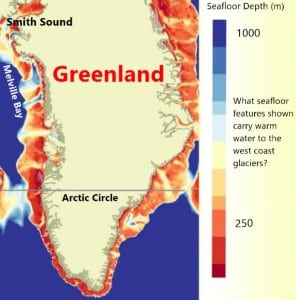
Who cares about Greenland and why is the Ocean Research Project team going there? About 90% of the island is covered in ice and the people and animals who live there rely on it staying froze. They live along the rocky fringes separated around the island by partially frozen fjords and towering dynamic marine terminating glaciers where their means of survival, traveling and hunting by dogsled is threatened. When the ice sheet eventually melts at least 21 feet of sea level rise will occur globally, but when? Our observations will help scientists from NASA to determine the stability of the ice sheet and predict when the water will be displaced.
Onboard the R/V Ault, Captain Matt and I are sailing to Greenland and are currently in the North Atlantic Ocean off Canada’s, Newfoundland where we have entered a maze of small ice bergs not far from where the Titanic cruise liner met a berg face to face. It is scary to sail to a near frozen world where you have to rely on yourself to survive but it is even scarier to ignore climate change and the impact it is having not just on the Arctic but on the entire planet. Just imagine, you could fill the Chesapeake Bay up 3 times each year with how much water is melting off of Greenland. How much of an impact does human civilization have to do with these changes?
Matt and I take turns sailing the boat, we help each other out when things get tough. 5 hours on, then 5 hours off, days go by and time becomes a blur especially as you head closer to the Arctic. As we head North eventually the sun will not set during the summer months. The tilt of the Earth’s axis and its position around the sun causes daylight around the clock. We have already climbed 10 degrees of latitude heading north, 16 more and we will be in the Arctic and if environmental circumstances allow we will study the climate change impacts of Smith Sound at 78 degrees North.
We aim to survey narrow fjords with rapidly melting glaciers especially in the less explored fjords of Melville Bay. There are dozens of fjords that are often too narrow for research planes to operate and to shallow for large research vessels to navigate safely. We are trying to find where the warm water is coming up and at what depth. Warm water is thought to be coming all the way from the North Atlantic Ocean traveling up over the shelf, through connecting deep water canyons, entering the glacial fjords only to eat away and melt the underbelly of the glaciers that stick out over the water. We will survey these uncharted regions to observe if this warm water is really coming up from the depths.

Cautiously we will approach glaciers to periodically drop a sensor, a RBR ltd. CTD (conductivity, temperature, depth device) all the way to the bottom to help identify where the warm water is and how fresh it is considering the adjacent glacial melt activity.
Since we left Annapolis, Maryland about 3 weeks ago we have recorded much about the ocean’s surface along the eastern seaboard such as: how much carbon is present, how salty it is, and what the temperature is. We have two automatic sampling systems installed aboard the R/V Ault to manage; an ocean carbon sampling Smithsonian pCO2 system and RBR’s thermosalinograph which mainly measures sea surface salinity and temperature. Why should we measure ocean carbon, salinity and the temperature of the surface of the ocean from a temperate to polar climate?
Avannaarsua, (Greenlandic translation: To the far North)
Nicole








